|
The Martinshof Story - Page 3
Page |
Previous |
Next ||
1 |
2 |
3 |
4 |
5 |
6 |
7 |
8 |
9 |
10 |
11 |
12 |
13 |
14 |
15 |
16 |
? |
Next -
Previous -
Top -
Page 1 -
Photos -
Michael's Blog -
Jazclass Links
10. Martinshof : 1945 - 1948
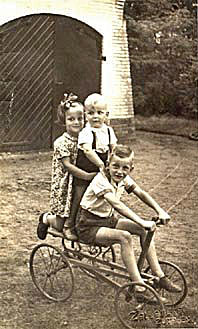 Us children (Wivica, Claus and I) coped reasonably well during the absence of our parents. Annie Martinus
and Eefje Maas combed our hair, cut our nails and scrubbed us clean every Friday
night in a large tub in the kitchen, and Grotie, our grandmother, read us stories
about Bolke de Beer (a friendly bear wandering the Harz and Black Forest in Germany)
every Sunday morning in bed.
Us children (Wivica, Claus and I) coped reasonably well during the absence of our parents. Annie Martinus
and Eefje Maas combed our hair, cut our nails and scrubbed us clean every Friday
night in a large tub in the kitchen, and Grotie, our grandmother, read us stories
about Bolke de Beer (a friendly bear wandering the Harz and Black Forest in Germany)
every Sunday morning in bed.
My mother meanwhile was transferred from the Oldenhof in Gorssel to another concentration camp between Laren and Lochem.
The Camp Commander
soon woke up to my mother's artistic talents and promoted her to sole member of her own
"Art Department".
This meant that she no longer had to go out to the farms and work the
fields but could work in her own art studio making beautiful dolls of straw and silk,
dressed in late 19th early 20th Century fashion.
 My mother was given all the materials she required and finished dolls were sold to shops in
the region, although my mother never received any money from that herself. (My mother also
made wonderful rural characters in Hessian material, but I am not sure whether this was
during this period or much later.)
My mother was given all the materials she required and finished dolls were sold to shops in
the region, although my mother never received any money from that herself. (My mother also
made wonderful rural characters in Hessian material, but I am not sure whether this was
during this period or much later.)
My father too was shifted around to various concentration camps. For a period he was held
in Blokzijl (just
NW of Zwolle) where he worked on new roads on the reclaimed land of Oost Flevoland. His
fellow inmates fondly named one of the roads Furstiaan weg after him. He was much
trusted and highly regarded by his fellow inmates and the camp wardens at several occasions relied
on him to calm things down during the odd troublesome situation.
My mother was
released after 18 months and returned home. Around that time Annie and Eefje left
Martinshof, the Jansen family had already preceded them in February 1946.
My father was eventually shifted
to a camp near Dieren where, in the
summer of 1948 we picked him up in a taxi, finally a free man again. Thirty three years
later (in 1981) he would find his final resting place at the Crematorium in Dieren, just one
kilometer away from the camp he had just left.
Next -
Previous -
Top -
Page 1 -
Photos -
Michael's Blog -
Jazclass Links
11. Atelier Martinshof - Maud Smit and Eweg
After the war my parent's jewelry
business in Zutphen was
confiscated by the Dutch Government, so when my father finished his 3 years internment
he had absolutely nothing.
Returning
to parochial Zutphen was for my parents out of the question. Instead, helped by a loan
from my grandmother he started a
new venture : Atelier Martinshof.
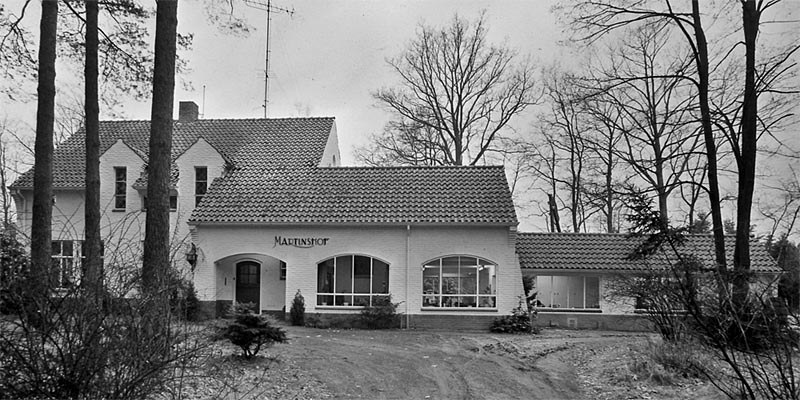 The garage of our home 'Martinshof' was converted into a
gold smith studio for Eweg the outstanding goldsmith who had worked
previously for my parents in their jewelry shop in Zutphen.
The garage of our home 'Martinshof' was converted into a
gold smith studio for Eweg the outstanding goldsmith who had worked
previously for my parents in their jewelry shop in Zutphen.
My father
was a most remarkable man. He always maintained that the creative aspects for the business
was always my mother's input and in a direct sense this was of course true. Perhaps
largely because of that, I have for many years largely overlooked the enormous creative force my
father himself was. He was the one with all the new ideas, right throughout his
professional life. And he was the man who sought out the right artists to carry out and
support his ideas.
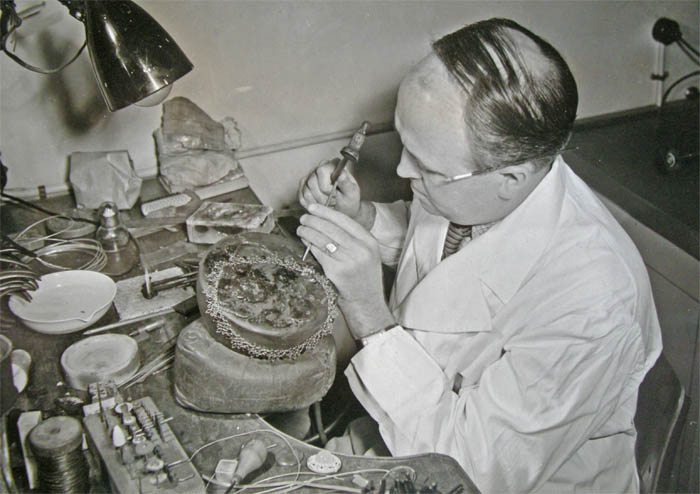 His first great find was the goldsmith from Indonesian origin Maud Smit. Together
with Eweg they formed the artistic core of Atelier Martinshof, Maud being the
creative designer while Eweg was the master craftsman. Maud Smit lived with us at
Martinshof. Eweg lived in nearby Warnsveld from where he every morning arrived on his
bicycle. Eweg had known me right from my birth in Zutphen and we became great
friends. He was a most kind and very patient man. I was fascinated with his work and
every afternoon rushed back home after school to stand right next to him watching the
gradual creation of just about every single piece of jewelry Eweg made.
His first great find was the goldsmith from Indonesian origin Maud Smit. Together
with Eweg they formed the artistic core of Atelier Martinshof, Maud being the
creative designer while Eweg was the master craftsman. Maud Smit lived with us at
Martinshof. Eweg lived in nearby Warnsveld from where he every morning arrived on his
bicycle. Eweg had known me right from my birth in Zutphen and we became great
friends. He was a most kind and very patient man. I was fascinated with his work and
every afternoon rushed back home after school to stand right next to him watching the
gradual creation of just about every single piece of jewelry Eweg made.
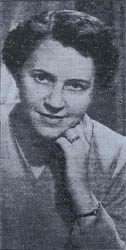 Maud Smit was the sole creator of the visual concept, face, style of the
Martinshof Collection. It was an enchanting fairy tale world of fish, birds,
seahorses, mermaids, surrounded by sparkling stones and enamel in yellow, green, red,
and blue in which Adam and Eve (brooch presently held by Antien) too participated. It
represented the beginning of a new era in jewelry design, a total departure from the then prevailing boring and rather uggly jewelry which (sadly) up to this
very day still has a considerable foothold in countries like the UK and Australia.
Maud Smit was the sole creator of the visual concept, face, style of the
Martinshof Collection. It was an enchanting fairy tale world of fish, birds,
seahorses, mermaids, surrounded by sparkling stones and enamel in yellow, green, red,
and blue in which Adam and Eve (brooch presently held by Antien) too participated. It
represented the beginning of a new era in jewelry design, a total departure from the then prevailing boring and rather uggly jewelry which (sadly) up to this
very day still has a considerable foothold in countries like the UK and Australia.
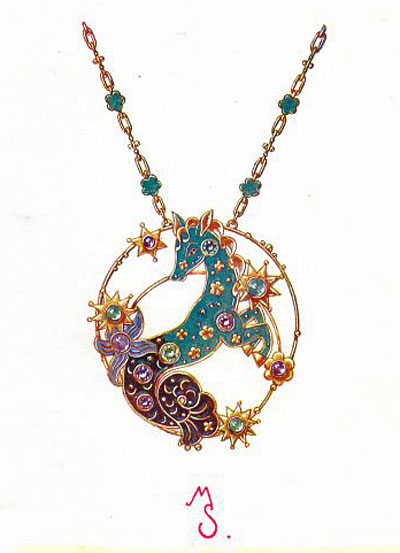 The signature piece of the collection was Het Zeepaardje ('The
Seahorse'), an absolutely magnificent gold multicolour enameled seahorse mounted on a
8cm (3 inches) diameter set of gold wire circles studded with various
coloured stones and stars. Its image was on the front page of all Martinshof
brochures. It was eventually sold, I have no idea to whom.
The signature piece of the collection was Het Zeepaardje ('The
Seahorse'), an absolutely magnificent gold multicolour enameled seahorse mounted on a
8cm (3 inches) diameter set of gold wire circles studded with various
coloured stones and stars. Its image was on the front page of all Martinshof
brochures. It was eventually sold, I have no idea to whom.
Next -
Previous -
Top -
Page 1 -
Photos -
Michael's Blog -
Jazclass Links
12. Atelier Martinshof - first Exposition in Hotel de Leeuwenbrug
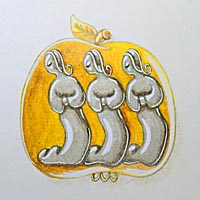 It took Eweg and Maud Smit about 6 months to created a collection large enough for an
exposition, which in mid 1949 took place in Hotel Restaurant de Leeuwenbrug in
Deventer.
It took Eweg and Maud Smit about 6 months to created a collection large enough for an
exposition, which in mid 1949 took place in Hotel Restaurant de Leeuwenbrug in
Deventer.
De
Leeuwenbrug (located diagonally opposite the Deventer Railway station) was in those days the most
distinguished place in town with an excellent restaurant (where my parents took us for
dinner to celebrate my graduation from High school in 1955), a distinguished formal
nightclub 'De Leeuwenkuil' ('The Lions' Lair') and a large light room for conferences or
expositions. Over the years the Leeuwenbrug lost its luster. It became a hostel for
Turkish guest workers in the 70's and when I visited Deventer last year (in 2008) it had been knocked
down and replaced by an office block.
The Martinshof exposition at De Leeuwenbrug was wonderful. The jewelry was displayed on several narrow
elongated tables covered right to the floor by magnificently burnt red plush cloth on which
the individual pieces were arranged on artistically draped small pieces of black silk.
Every visitor of the show was most impressed and enthusiastic about the collection.
However this was a time just after the war (WW2) that people spent their money on basics
which they had gone without for so long. Consumerism was just starting in Europe and
people saved up to buy those wonderful new things like electric washing machines,
fridges, radios, turntables, a telephone, even a car. Jewelry, no matter how beautiful,
was at the very bottom of the wish list, so in the end only a few items of the collection
were actually sold.
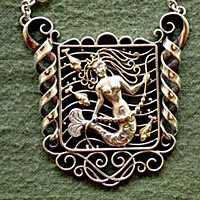 The outcome of that very first exposition could perhaps have been very different however and the question mark about
this lingers in my mind up to this day.
The outcome of that very first exposition could perhaps have been very different however and the question mark about
this lingers in my mind up to this day.
There was an American visitor to our
show. He was, according to my father's account, hugely enthusiastic about it and offered
my dad to buy the entire collection to take home and sell in the USA. I vividly remember
my father discussing this at the dinner table one evening. In the end he decided to
decline the offer. It had taken him a long time to build up the collection and it would
mean starting all over again. We all agreed with him at the time.
Was the offer made a bona fide one ? I have no idea and
as a child I was of course not privy to the complete story of it all. I also think
that the American would probably have persisted a bit more if his offer had been a
genuine one. But if the offer was genuine, rejecting it could have been the biggest business mistake we ever made. After
the war America, unlike ravaged and poor Europe, was flooded with money and wealth. Our
jewelry may well have sold there like hot cakes. But in Europe the prevailing
image we had of Americans was the typical American tourist in shorts with a loud tie,
camera around his neck and with a rather poor taste.
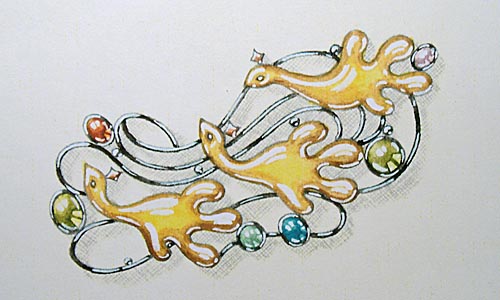 About a year later a selection of the Atelier Martinshof Collection did in fact go across the Atlantic to the USA. It represented jewelry art of the Netherlands at the Holland Fair in Philadelphia, as this article in the daily newspaper De Telegraaf of 21 March, 1950 testifies.
About a year later a selection of the Atelier Martinshof Collection did in fact go across the Atlantic to the USA. It represented jewelry art of the Netherlands at the Holland Fair in Philadelphia, as this article in the daily newspaper De Telegraaf of 21 March, 1950 testifies.
These type of shows however are generally mainly for the general public, rather than professional buyers in the trade and no substantial benefit ever came from it as far as I can remember.
Comments -
Next -
Previous -
Top -
Page 1 -
Photos -
Michael's Blog -
Jazclass Links
Copyright © 2009 Michael Furstner
|








